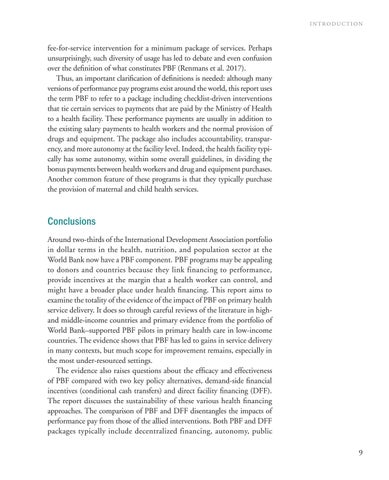INTRODUCTION
fee-for-service intervention for a minimum package of services. Perhaps unsurprisingly, such diversity of usage has led to debate and even confusion over the definition of what constitutes PBF (Renmans et al. 2017). Thus, an important clarification of definitions is needed: although many versions of performance pay programs exist around the world, this report uses the term PBF to refer to a package including checklist-driven interventions that tie certain services to payments that are paid by the Ministry of Health to a health facility. These performance payments are usually in addition to the existing salary payments to health workers and the normal provision of drugs and equipment. The package also includes accountability, transparency, and more autonomy at the facility level. Indeed, the health facility typically has some autonomy, within some overall guidelines, in dividing the bonus payments between health workers and drug and equipment purchases. Another common feature of these programs is that they typically purchase the provision of maternal and child health services.
Conclusions Around two-thirds of the International Development Association portfolio in dollar terms in the health, nutrition, and population sector at the World Bank now have a PBF component. PBF programs may be appealing to donors and countries because they link financing to performance, provide incentives at the margin that a health worker can control, and might have a broader place under health financing. This report aims to examine the totality of the evidence of the impact of PBF on primary health service delivery. It does so through careful reviews of the literature in highand middle-income countries and primary evidence from the portfolio of World Bank–supported PBF pilots in primary health care in low-income countries. The evidence shows that PBF has led to gains in service delivery in many contexts, but much scope for improvement remains, especially in the most under-resourced settings. The evidence also raises questions about the efficacy and effectiveness of PBF compared with two key policy alternatives, demand-side financial incentives (conditional cash transfers) and direct facility financing (DFF). The report discusses the sustainability of these various health financing approaches. The comparison of PBF and DFF disentangles the impacts of performance pay from those of the allied interventions. Both PBF and DFF packages typically include decentralized financing, autonomy, public 9

